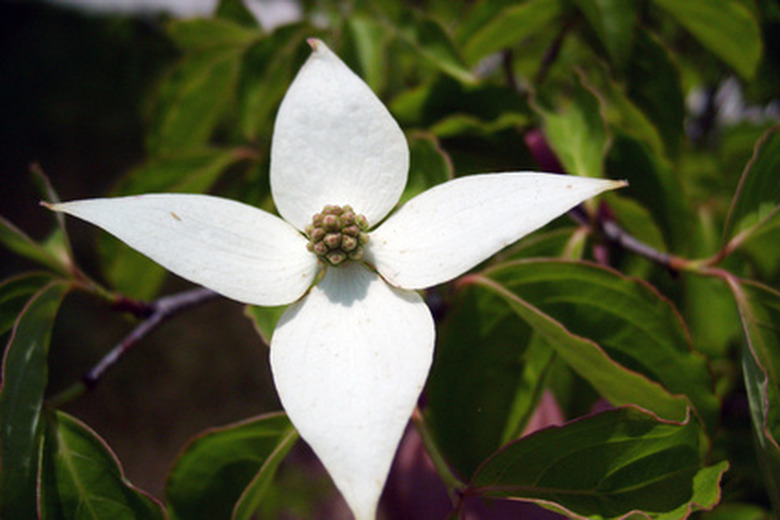Facts About The Aurora Dogwood Tree
Attacks by insect borers and anthracnose disease on native flowering dogwood trees across the eastern United States led plant breeders at Rutgers University to create a tree resilient to both. The Aurora dogwood (Cornus "Rutban") bears very large white bracts in mid-spring, after flowering dogwoods but just before kousa dogwoods bloom. Grow this deciduous tree in U.S. Department of Agriculture winter hardiness zones 6 through 9.
Origins
In the 1980s, Dr. Elwin Orton of Rutgers University in New Jersey crossed native flowering dogwood (Cornus florida) with the Japanese or kousa dogwood (Cornus kousa). The seedlings carried desirable traits of both parents and were selected for their flower color or other characteristics and grouped into the Rutgers Stellar Series. The seedling with cultivar name 'Rutban' was registered and given the U.S. plant patent #7205 and trademark name of Aurora.
Description
The Aurora dogwood is a deciduous tree with an upright and pyramid-like shape and dense, spreading branches. When young, it has a vase-like shape. Aurora dogwood grows to a mature size of 25 feet tall and equally wide. In early spring, its green oval leaves emerge and by mid-spring, the tiny clusters of yellow-green flowers are surrounded by large, showy white bracts. Each "blossom" comprises four overlapping bracts. The tree is heavily festooned with the flowers, making it look as though it is covered with heavy snow. In autumn, the leaves turn attractive shades of burgundy, orange and red before falling off. On old trees the bark exfoliates.
- Attacks by insect borers and anthracnose disease on native flowering dogwood trees across the eastern United States led plant breeders at Rutgers University to create a tree resilient to both.
- The Aurora dogwood (Cornus "Rutban") bears very large white bracts in mid-spring, after flowering dogwoods but just before kousa dogwoods bloom.
Features
Aurora dogwood is resistant to infestation by insect borers and the foliage fungal disease anthracnose. The flowers are sterile and will not yield seeds. Occasionally, some flowers develop incomplete fruits that tend to abort. The Aurora tolerates more direct sunlight than the flowering dogwood, but looks better when given light shade, unlike its sun-loving parent the kousa dogwood.
Growing Requirements
Aurora dogwood should be planted in a fertile, moist but well-draining soil that is acidic to slightly alkaline in pH (5.0 to 8.0). It looks best when situated in a partially sunny location, receiving between six and nine hours of direct sun rays daily, with some shade in the summer midday hours. Watering the tree during dry weather periods is necessary, as it is not tolerant of dry soil, especially when temperatures are hot.
- Aurora dogwood is resistant to infestation by insect borers and the foliage fungal disease anthracnose.
- The Aurora tolerates more direct sunlight than the flowering dogwood, but looks better when given light shade, unlike its sun-loving parent the kousa dogwood.
Legal Warning
This hybrid tree is protected by the U.S. Patent Act and cannot be reproduced except by the original breeder or those authorized by the holder of the plant patent. Only if and after the patent expires can others legally propagate the plant.
